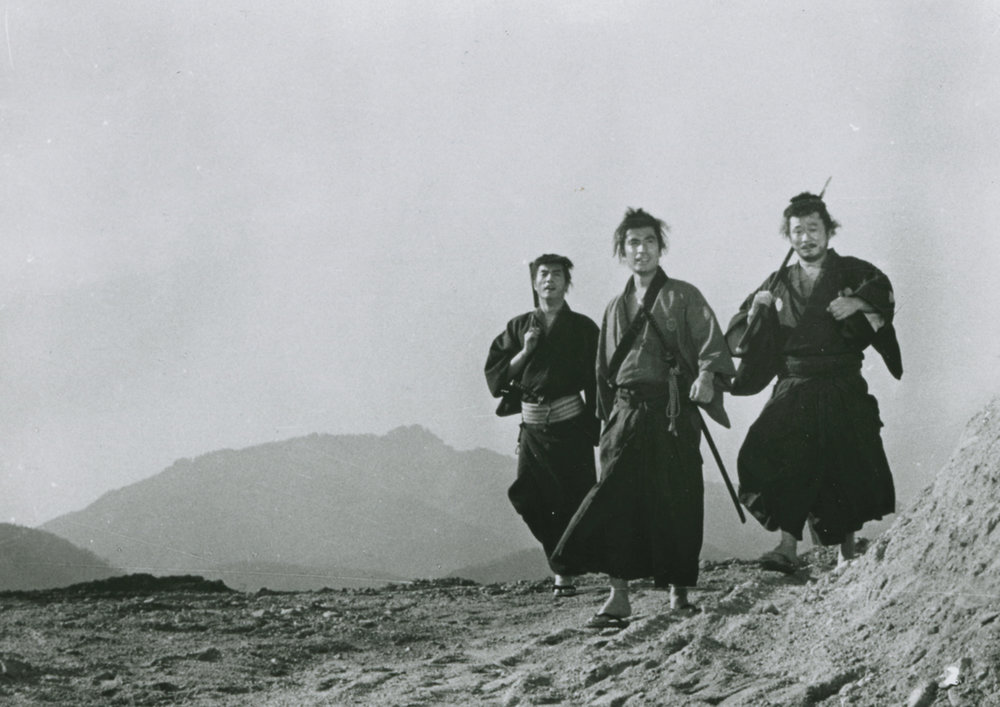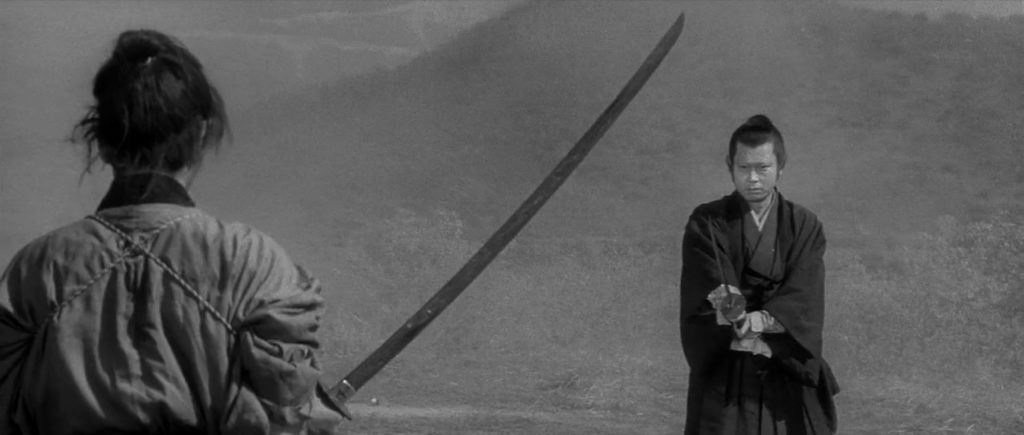| Lucas Hardwick |

Three Outlaw Samurai plays at the Trylon Cinema from Sunday, August 13th, through Tuesday, August 15th. Visit trylon.org for tickets and more information.
Way back in cable television’s Mesozoic era—when networks like the Independent Film Channel showed, you know, independent films, in the wee hours of Saturday morning right as Friday night’s winos and third-shifters were drifting off to sleep—one could turn on the TV to IFC and find a stretch of programming called Samurai Saturdays. The lucky few who stumbled upon this refined block of entertainment (because no one has ever been awake this early at their own free will on a Saturday), would discover a piece of world cinema waiting for them in the form of Japanese samurai films.
I recall waking during this rarefied time one such Saturday for work or some other silly responsibility and flipping on the TV to unearth a piece of what I came to know as Akira Kurosawa’s Yojimbo (1961). A budding film buff at the time, and having heard Kurosawa’s name muttered by George Lucas as an influence for Star Wars in some long-lost interview, I was struck by this opportunity to not only catch a glimpse of the work of a classic filmmaker who apparently had something to do with my childhood, but also the chance to look into the past and see an interpretation of the oft unspoken world of feudal Japan. Conveniently, Quentin Tarantino’s samurai sword-addled Kill Bill (2003) was also slashing its way into everyone’s consciousness at the time, making Samurai Saturdays most likely a premeditated move by the high sheriffs at IFC to cash in on the *sigh/eyeroll* zeitgeist. At any rate, the confluence of my 22-year-old interests had merged into this singular spot.
If you’ve seen Yojimbo or Seven Samurai then you can probably imagine my excitement when I first heard about Hideo Gosha’s Three Outlaw Samurai. The title alone promised something so inherently cool as a grizzled Toshiro Mifune setting about to outsmart and out-slice a bunch of delinquent goons, times three!
Well, not quite.
Three Outlaw Samurai is the story of a town brought to a state of turmoil by the hands of its bureaucratic ruler, all too happy to please the leader of the clan at any cost. Wandering samurai Sakon Shiba (Tetsurô Tanba) happens upon three farmers who’ve taken Magistrate Mosuke’s (Hisashi Igawa) daughter, Aya (Miyuki Kuwano), hostage and their demands for lower taxes is the ransom. The farmers’ rebellious nature appeals to Shiba’s cynical unemployed state, and the wayward samurai enlists himself to help fuck up the system that abandoned him so. When Mosuke learns the farmers are being aided by a samurai, he sends an army of those loyal to him to usurp the usurpers. And in a disruptive dynamic that underscores the film’s cynical anti-establishment message, two of the magistrate’s own men turn on him—including his own personal bodyguard (yojimbo is the Japanese word for “bodyguard,” by the way)—to help Shiba and the farmers execute the inevitable coup.

Three Outlaw Samurai: Mikijirô Hira as Kikyo (left), Tetsurô Tanba as Sakon Shiba
(center), and Isamu Nagato as Sakura (right)
But before we can really appreciate Three Outlaw Samurai and how uniquely Japanese it really is, it’s important to reconcile a few mistaken assumptions about Japanese cinema perpetuated by popular culture and the relentless juggernaut of Akira Kurosawa’s expansive sway on Western—specifically American—filmmakers.
Yojimbo, of course, influenced the drifter cowboy trope made all the more famous in Sergio Leone’s Man With No Name/Dollars Trilogy. The first of those films, A Fistful of Dollars (1964), is a direct remake of Yojimbo. Prior to that, Kurosawa’s period epic Seven Samurai (1954) is copied in John Sturges’ The Magnificent Seven (1960). And in 1977, George Lucas replicates and transposes the feudal era set The Hidden Fortress (1958) into a swashbuckling space opera that built a legacy of dudes in robes who wield lightsabers in place of katanas and live by a code not unlike the samurai bushido.
But if Kurosawa’s take on feudal Japan seems a might Western, it’s no mistake. The director admits to being heavily influenced by the likes of John Ford. On a larger scale, Kurosawa was a master at retelling Shakespeare’s works, converting plays like King Lear into the period Japanese epic Ran (1985). The affect of Kurosawa on Western filmmakers is a strange self-indulgent simulacrum of not only samurai, but the notion of influence itself. There is nothing new under the sun.
“Kurosawa was a master filmmaker, you sonofabitch! How dare you!”
Shhh.
When anyone thinks of the drifting ronin samurai, the first thing referenced is almost always Yojimbo. Yojimbo is the gateway film a lot of people glom on to that fosters the overnight world cinema hobbyist, or it’s the singular film that lends minor credibility to the casual movie buff and makes him or her the office “movie guy or girl.”
“Hey Barry, what was that Japanese flick you were talking about the other day? The samurai cowboy thing?”
Yojimbo was one of Kurosawa’s most widely known films and one of his most successful. While Western audiences thought they were getting a piece of real ancient Japanese culture, Kurosawa was feeding their own narrative tropes right back to them. All that is to say, when we think of the lone samurai, we will almost always default to Toshiro Mifune as Sanjuro in Kurosawa’s Yojimbo. It’s one of those things that’s ingrained in popular culture. Whether you’ve seen the film or not, thanks to and because of Yojimbo there exists the idea of the drifting samurai.
The thing about Sanjuro is he’s not really a samurai at all. Other characters in the film refer to him as a samurai in passing, mostly because he’s dressed for the part. There’s not even a mention of honoring any kind of samurai code. He’s brash, defensive, cocky, almost unapproachable. And the thing that makes him the least Japanese of all is, Sanjuro is confident. There is an old Japanese proverb: “The nail that sticks out is hammered down.” Sanjuro’s main goal in Yojimbo is to disrupt, to be “the nail that sticks out,” and in a very Western way, to not get hammered down. None of this is to say Japanese aren’t confident—settle down—but Japanese culture is rife with customs and sayings that convey a sense of humility (seppuku, anyone?), and Sanjuro has none. At one point in the film, he says to a couple he just rescued from the fallout of dueling town gangs, “I hate pathetic weaklings. Start crying and I’ll kill you.” WTF, dude?!

Samurai cowboy, Toshiro Mifune as Sanjuro in Yojimbo
In Yojimbo, Sanjuro interjects himself between two groups of ruffians fighting for control of the turf. All the while, the regular people in town are caught in the middle. Sanjuro wanders in and begins the rather tediously plotted (a.k.a. mildly boring) task of pitting the gangs against each other in hopes to restore peace and order. Now chances are, this village is ruled by some magistrate. The magistrate answers to the daimyo who is the hereditary leader of the clan. And when maintaining samurai became too expensive and the class was abolished in the late 19th century, samurai were turned out on the streets by these leaders, and guess who then had the right to have a chip on their shoulder about feudal Japanese hierarchy. Guess who theoretically couldn’t care less about political infrastructure, a.k.a. whether or not a town is torn asunder by barbaric gangs (the answer is: an unemployed samurai).
Yojimbo’s Sanjuro is a replication of the American cowboy—which is fine! It makes for great, heightened entertainment and showcases a cool confident hero not unlike John Wayne. And though what’s happening with Sanjuro is really pretty cool on screen, what’s frustrating is it arrives from elements we in the West are all too familiar with. Kurosawa is indeed a Japanese filmmaker, and by that rationale, Yojimbo is automatically imbued with a sense of Japanese culture, but fundamentally Yojimbo is something less authentic than what we think we’ve signed up for. In the case of Yojimbo most specifically, it’s easy to believe you’re watching a samurai film, but what Kurosawa has actually made is an American Western.
While the drifter cowboy is not unlike the roving samurai, the roving samurai is not unlike the drifter cowboy, which suggests that something more elemental is at hand; something that appeals to our inner Arthur Fonzarelli. The wayward samurai should be cranky and cynical, and though devoted to a code of honor that in a transient state often only goes as far as the situation at hand, has no use for the capital E Establishment. Once wealthy retainers of officer caste for the rulers of medieval Japan, the wandering samurai have been rejected by the system. The wandering samurai is recalcitrant and dubious. His story is anything but Western in that it subverts expectations and demands fluid anticipation. And in as much as the itinerant samurai kicks against the pricks, in a true sense of zen, he is also like water. He is a mercenary. He isn’t a cowboy; he is punk rock.

The final showdown.
And as much as Sanjuro is an ersatz cowboy, Three Outlaw Samurai‘s Sakon Shiba is anything but. In fact, Shiba’s first few moments on screen anticipate our perception of him and then immediately subverts our judgements as he reveals his true nature. When Shiba discovers the three farmers who’ve taken a woman hostage, he first asks if the men have raped her, leading us to assume courageous ideals about the man. For a moment we believe Shiba’s and the film’s intentions will be to rescue this woman and bring her captors to justice—a very traditionally Western conceit. But when the farmers reveal that she is the daughter of the local magistrate and that they’re holding her hostage in favor of fairer treatment by the village leadership, we quickly learn that Shiba’s got an infrastructural axe to grind. This subversion not only sets the story in motion, but the tone of the rest of the film as well, as the two samurai who join Shiba are both not only at one time are loyal to the magistrate, they are also anything but heroic.
Unlike Yojimbo, which basically glorified the lone samurai who’d been kicked out by his government, Three Outlaw Samurai cleverly calls out the then-current post-war situation that saw U.S. occupation on Japanese soil under the Treaty of Mutual Cooperation and Security, established by the U.S. and Japanese governments. While Yojimbo extolled the very Western culture that just 16 years prior had nuked the shit out of the nation, Three Outlaw Samurai is a quaintly disguised commentary that aligns with the handful of groups like the Japan Socialist Party and the Kōmeitō—a new Buddhist religious movement during that time—that favored the annulment of the nation’s mutual security agreement with the U.S. And much like the politics within the film that sees former government employees using the bourgeoisie to execute a government takeover, the movie’s subtext shrewdly slices and dices through contextual affairs to suggest its revolutionary message.

Big Harrison Ford vibes from actor Tetsurô Tanba as Sakon Shiba.
This is all supposed to prepare you for when the Trylon blasts the title Three Outlaw Samurai across its marquee you won’t walk in expecting “Three Yojimbos.” In fact, what you can expect is a film brimming with sword-swinging action and plenty of noble Japanese lowliness that’s a sight more thoughtful than any Yojimbosor the cowboy copies we’ve come to expect from the drifting samurai.But if all this doesn’t really mean anything to you and you’re a Samurai Saturdays kind of person, you’re still in for a real treat. Tetsurô Tanba’s Sakon Shiba evokes a Harrison Ford aloofness that matches the crude Western intensity of Toshiro Mifune’s Sanjuro in a dynamic story that’ll topple your expectations like a Meiji era samurai.
Edited by Olga Tchepikova-Treon
